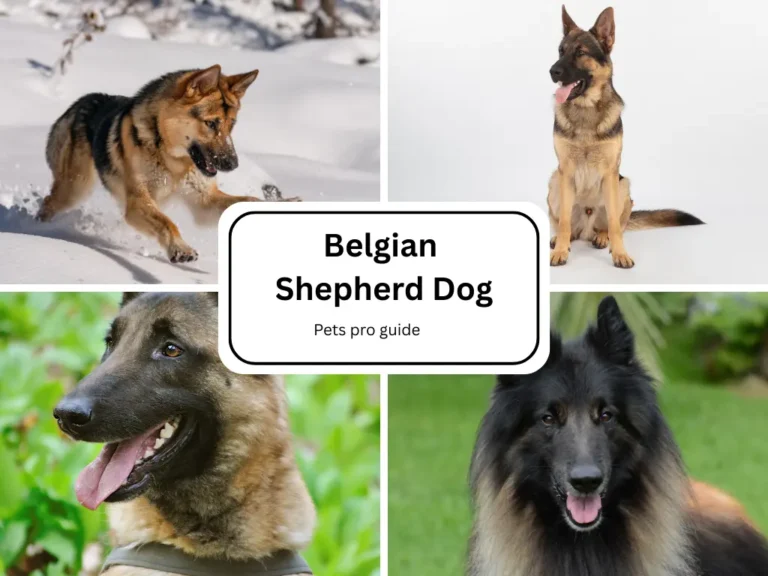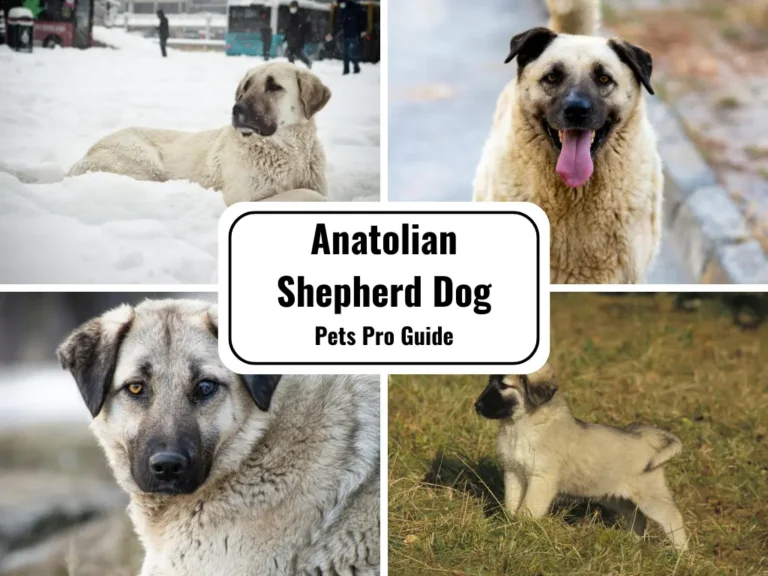Doberman Pinschers Breed Information: Welcome, readers! Anastasia here, ready to divulge all you need to know about Doberman Pinschers breed, complete with a delightful compilation of heartwarming pictures!
Doberman Pinschers, one of the most iconic and beloved dog breeds. In this article, we’ll delve into the world of Dobermans, providing you with insights into their history, characteristics, care, and much more. Whether you’re a dedicated Doberman enthusiast or considering adding one to your family, this guide has something for everyone.
Doberman Pinschers, often referred to as simply “Dobermans,” are known for their striking appearance, unwavering loyalty, and remarkable intelligence. These dogs are the embodiment of strength and elegance, making them a popular choice for various roles, from family pets to working dogs. Let’s embark on a journey to discover the fascinating world of Doberman Pinschers.
- Core statistics
- History and Origins
- Other Names for Doberman Pinschers Breed
- Doberman Pinschers Size & Weight
- Appearance
- Personality
- Temperament
- Nutrition and Feeding
- Doberman Pinschers Space Requirements
- Training & Exercise
- Doberman Pinschers Grooming
- General Introduction about Doberman Pinschers
- Origin and History of Doberman Pinschers
- Other Names for Doberman Pinschers
- Doberman Pinschers Size & Weight
- Doberman Pinschers Appearance
- Doberman Pinschers Personality
- Doberman Pinschers Temperament
- Doberman Pinschers Nutrition and Feeding
- Doberman Pinschers Space Requirements
- Doberman Pinschers Training & Exercise
- Doberman Pinschers Grooming
- Common Doberman Pinschers Breed Health Conditions
- Doberman Pinschers Care Pro Tips
- Is Doberman Pinschers Good Family Dog?
- What to know before you buy a Doberman Pinschers?
- Doberman Pinschers Breed Fun Facts
- FAQs
- 1. Are Dobermans good with children?
- 2. Do Dobermans shed a lot?
- 3. Are Dobermans aggressive?
- 4. Do Dobermans make good guard dogs?
- 5. How often should I groom my Doberman?
- 6. Are Dobermans prone to specific health conditions?
- 7. Can Dobermans live in apartments?
- 8. Are Dobermans easy to train?
- 9. Do Dobermans need a lot of exercise?
- 10. How long do Dobermans live on average?
- Conclusion
- Read More
Also Read: Doberman Pinschers Breed Information

Core statistics
Here are some core statistics:
- Size: Large
- Coat: Short and smooth
- Exercise: 4+ hours a day
- Life span: 8-10 years
- Breed group: Dog
- Temperament: Easy-going, loyal, affectionate
History and Origins
Doberman Pinschers owe their name and origin to a 19th-century German tax collector and dog breeder, Karl Friedrich Louis Dobermann. Dobermann’s desire to create a loyal and protective canine companion led to the breeding of these dogs. The breed combines the traits of several breeds, including the Rottweiler, Greyhound, German Pinscher, and others, resulting in the impressive Doberman we know today.
Other Names for Doberman Pinschers Breed
Here are some other names for Labrador Retriever:
Doberman Pinschers are known by various names worldwide, reflecting their diverse popularity and reputation:
- Dobermann (original German name)
- Doberman
- Doberman Pinscher
- Doberman-Deutschland (in Germany)
Doberman Pinschers Size & Weight
Male Doberman Pinschers:
- Size: 26 to 28 inches at the shoulder
- Weight: 75 to 100 pounds
- Life Expectancy: 10 to 13 years
Female Doberman Pinschers:
- Size: Slightly smaller than males
- Weight: 60 to 90 pounds
- Life Expectancy: 10 to 13 years
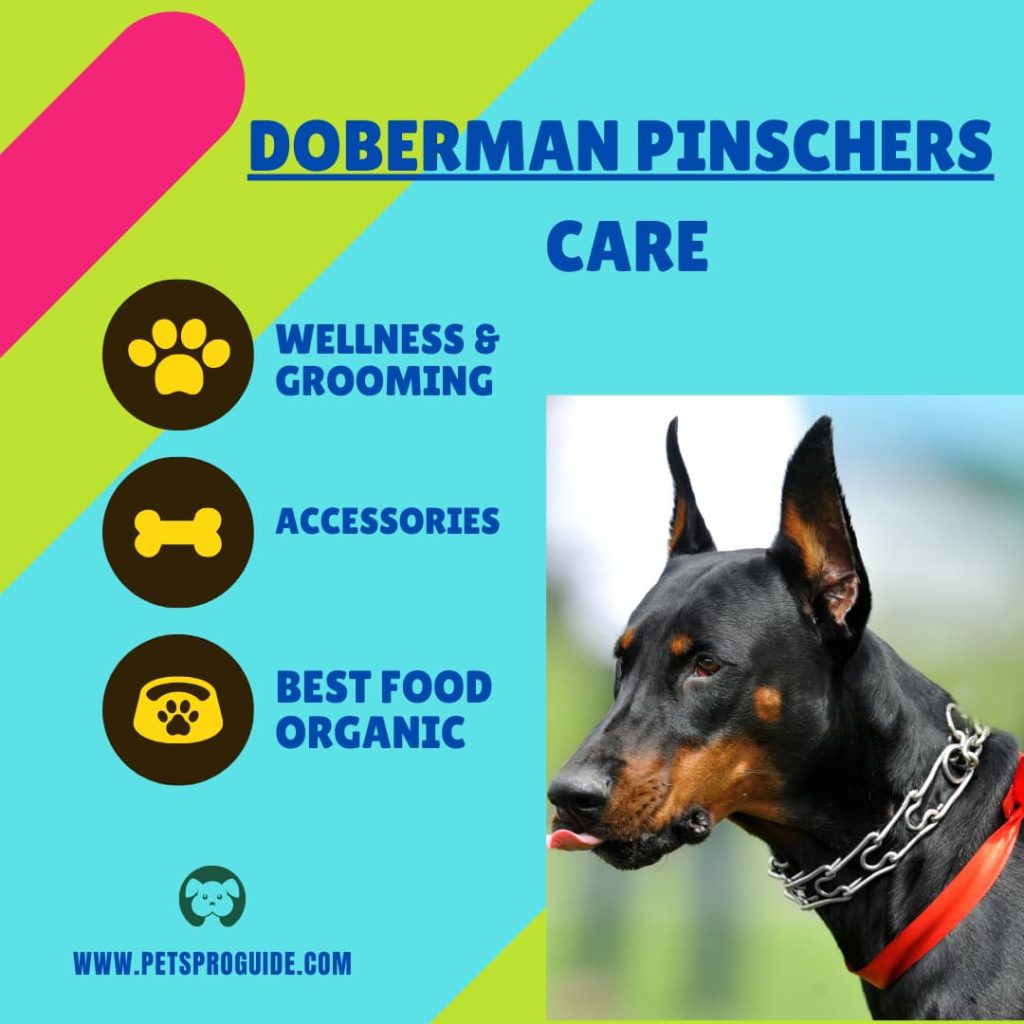
Appearance
Dobermans are easily recognizable by their sleek and muscular bodies, with a short, shiny coat that can be black and tan, blue and tan, red and rust, or fawn and rust. Their wedge-shaped heads, powerful jaws, and alert, almond-shaped eyes give them a regal and imposing appearance. Their docked tails and cropped ears, though less common today, were traditionally used for practical and historical reasons.
Personality
Doberman Pinschers are celebrated for their loyal, intelligent, and protective nature. They form strong bonds with their families and are known for their devotion. Despite their imposing appearance, they are often gentle and loving companions, making them excellent family pets.
Temperament
Dobermans have a unique temperament that combines loyalty, intelligence, and confidence:
- Alertness: Dobermans are exceptionally vigilant and make excellent watchdogs.
- Trainability: They are quick learners and excel in obedience training.
- Protectiveness: Dobermans have a protective instinct, making them fiercely loyal.
- Elegance: Their refined demeanor is a striking feature of their temperament.
Nutrition and Feeding
To maintain the health and vitality of your Doberman Pinscher, it’s crucial to provide them with a balanced diet. Follow these tips for optimal nutrition:
- Choose high-quality dog food.
- Stick to a regular feeding schedule.
- Measure portions to avoid overfeeding.
- Avoid feeding them human food, especially items that can be toxic to dogs.
- Ensure they have access to clean, fresh water at all times.

Doberman Pinschers Space Requirements
For Puppies: Doberman puppies are energetic and require a safe indoor space to play and explore. They benefit from early socialization and gentle training.
For Adults: Adult Dobermans adapt well to various living situations, including apartments and houses with yards. However, they need daily exercise to stay happy and healthy.
Training & Exercise
Training and exercise are essential to maintaining a well-rounded Doberman Pinscher. Here are ten crucial points to consider:
- Early Socialization: Expose your Doberman to various people, animals, and environments.
- Obedience Training: Teach basic commands like sit, stay, and come.
- Consistency: Be consistent with your commands and expectations.
- Positive Reinforcement: Reward good behavior with treats and praise.
- Exercise: Dobermans are active dogs and require regular exercise.
- Crate Training: Introduce them to a crate as a safe space.
- House Training: Establish a consistent potty training routine.
- Leash Training: Get them accustomed to walking on a leash.
- Mental Stimulation: Provide puzzle toys and challenges to keep them sharp.
- Barking Control: Train them to be quieter when needed.
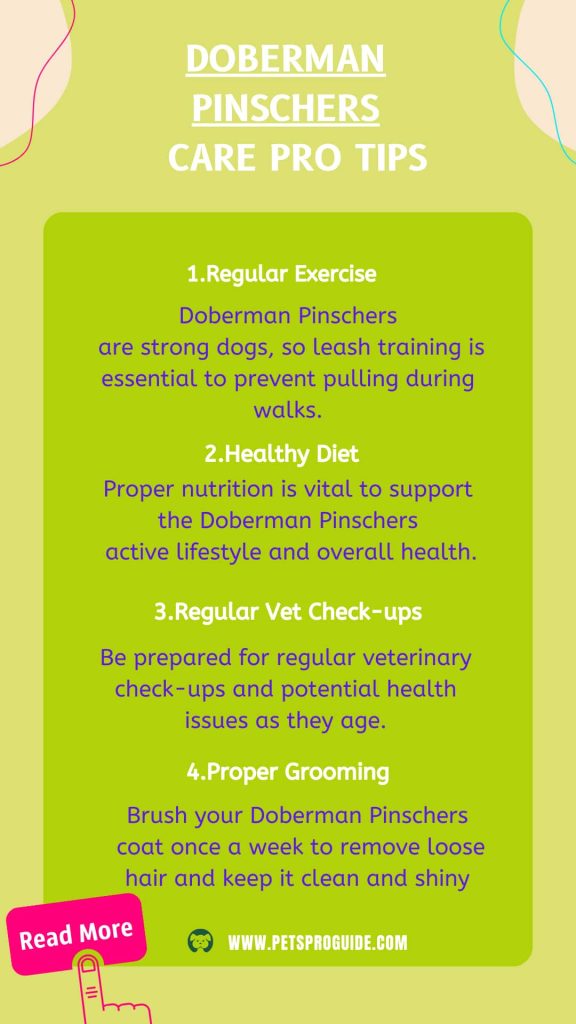
Doberman Pinschers Grooming
Dobermans are relatively low-maintenance in the grooming department. Here are five tips to keep your Doberman looking and feeling their best
- Brushing: Their short coat only requires occasional brushing to remove loose hair.
- Bathing: Bathe them when necessary, but not too frequently to avoid skin issues.
- Ear Cleaning: Keep their ears clean and dry to prevent infections.
- Nail Trimming: Trim their nails regularly to prevent overgrowth.
- Dental Care: Brush their teeth regularly to maintain oral health.
- Doberman Pinschers Breed Information and Pictures
Welcome to our comprehensive guide on Doberman Pinschers, one of the most iconic and beloved dog breeds. In this article, we’ll delve into the world of Dobermans, providing you with insights into their history, characteristics, care, and much more. Whether you’re a dedicated Doberman enthusiast or considering adding one to your family, this guide has something for everyone.
General Introduction about Doberman Pinschers
Doberman Pinschers, often referred to as simply “Dobermans,” are known for their striking appearance, unwavering loyalty, and remarkable intelligence. These dogs are the embodiment of strength and elegance, making them a popular choice for various roles, from family pets to working dogs. Let’s embark on a journey to discover the fascinating world of Doberman Pinschers.
Origin and History of Doberman Pinschers
Doberman Pinschers owe their name and origin to a 19th-century German tax collector and dog breeder, Karl Friedrich Louis Dobermann. Dobermann’s desire to create a loyal and protective canine companion led to the breeding of these dogs. The breed combines the traits of several breeds, including the Rottweiler, Greyhound, German Pinscher, and others, resulting in the impressive Doberman we know today.
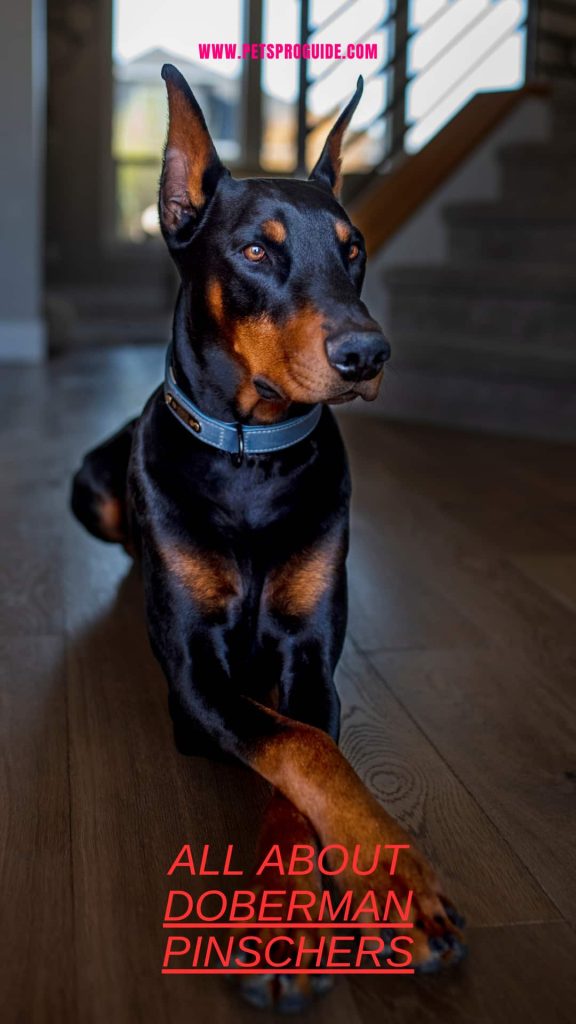
Other Names for Doberman Pinschers
Doberman Pinschers are known by various names worldwide, reflecting their diverse popularity and reputation:
- Dobermann (original German name)
- Doberman
- Doberman Pinscher
- Doberman-Deutschland (in Germany)
Doberman Pinschers Size & Weight
Male Doberman Pinschers:
- Size: 26 to 28 inches at the shoulder
- Weight: 75 to 100 pounds
- Life Expectancy: 10 to 13 years
Female Doberman Pinschers:
- Size: Slightly smaller than males
- Weight: 60 to 90 pounds
- Life Expectancy: 10 to 13 years
Doberman Pinschers Appearance
Dobermans are easily recognizable by their sleek and muscular bodies, with a short, shiny coat that can be black and tan, blue and tan, red and rust, or fawn and rust. Their wedge-shaped heads, powerful jaws, and alert, almond-shaped eyes give them a regal and imposing appearance. Their docked tails and cropped ears, though less common today, were traditionally used for practical and historical reasons.
Doberman Pinschers Personality
Doberman Pinschers are celebrated for their loyal, intelligent, and protective nature. They form strong bonds with their families and are known for their devotion. Despite their imposing appearance, they are often gentle and loving companions, making them excellent family pets.
Doberman Pinschers Temperament
Dobermans have a unique temperament that combines loyalty, intelligence, and confidence:
- Alertness: Dobermans are exceptionally vigilant and make excellent watchdogs.
- Trainability: They are quick learners and excel in obedience training.
- Protectiveness: Dobermans have a protective instinct, making them fiercely loyal.
- Elegance: Their refined demeanor is a striking feature of their temperament.
Doberman Pinschers Nutrition and Feeding
To maintain the health and vitality of your Doberman Pinscher, it’s crucial to provide them with a balanced diet. Follow these tips for optimal nutrition:
- Choose high-quality dog food.
- Stick to a regular feeding schedule.
- Measure portions to avoid overfeeding.
- Avoid feeding them human food, especially items that can be toxic to dogs.
- Ensure they have access to clean, fresh water at all times.
Doberman Pinschers Space Requirements
For Puppies: Doberman puppies are energetic and require a safe indoor space to play and explore. They benefit from early socialization and gentle training.
For Adults: Adult Dobermans adapt well to various living situations, including apartments and houses with yards. However, they need daily exercise to stay happy and healthy.
Doberman Pinschers Training & Exercise
Training and exercise are essential to maintaining a well-rounded Doberman Pinscher. Here are ten crucial points to consider:
- Early Socialization: Expose your Doberman to various people, animals, and environments.
- Obedience Training: Teach basic commands like sit, stay, and come.
- Consistency: Be consistent with your commands and expectations.
- Positive Reinforcement: Reward good behavior with treats and praise.
- Exercise: Dobermans are active dogs and require regular exercise.
- Crate Training: Introduce them to a crate as a safe space.
- House Training: Establish a consistent potty training routine.
- Leash Training: Get them accustomed to walking on a leash.
- Mental Stimulation: Provide puzzle toys and challenges to keep them sharp.
- Barking Control: Train them to be quieter when needed.
Doberman Pinschers Grooming
Dobermans are relatively low-maintenance in the grooming department. Here are five tips to keep your Doberman looking and feeling their best:
- Brushing: Their short coat only requires occasional brushing to remove loose hair.
- Bathing: Bathe them when necessary, but not too frequently to avoid skin issues.
- Ear Cleaning: Keep their ears clean and dry to prevent infections.
- Nail Trimming: Trim their nails regularly to prevent overgrowth.
- Dental Care: Brush their teeth regularly to maintain oral health.
Common Doberman Pinschers Breed Health Conditions
While Dobermans are generally healthy dogs, they can be prone to specific health issues. Here are ten common health conditions to be aware of:
- Dilated Cardiomyopathy (DCM): A heart condition prevalent in Dobermans.
- Hip Dysplasia: A genetic condition affecting the hip joint.
- Wobbler’s Syndrome: A spinal cord condition that can cause wobbling or weakness.
- Hypothyroidism: An underactive thyroid condition.
- Von Willebrand’s Disease: A blood clotting disorder.
- Bloat: A potentially life-threatening condition where the stomach fills with gas.
- Cervical Spondylomyelopathy: A neck condition that can lead to paralysis.
- Skin Conditions: Dobermans can be prone to various skin issues.
- Osteosarcoma: A type of bone cancer that can affect the breed.
- Allergies: Some Dobermans may develop allergies to food or environmental factors.
Doberman Pinschers Care Pro Tips
To ensure the well-being of your Doberman, consider the following care tips:
- Regular Veterinary Check-ups: Schedule annual check-ups and vaccinations.
- Weight Management: Maintain their weight in a healthy range.
- Exercise: Provide daily exercise to keep them physically and mentally active.
- Nutritious Diet: Feed them high-quality dog food.
- Dental Care: Regularly brush their teeth.
- Hydration: Ensure they have access to fresh water.
- Grooming: Maintain their coat, nails, and ears.
- Socialization: Expose them to different people and animals.
- Training: Invest time in
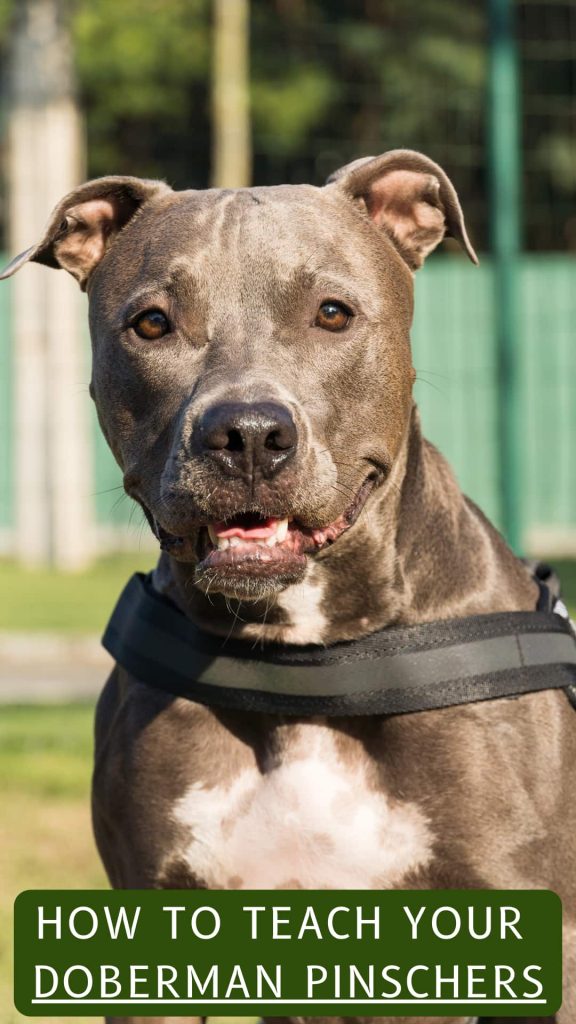
Is Doberman Pinschers Good Family Dog?
Yes, Dobermans can make excellent family pets when well-trained and socialized from a young age. Their loyalty and protective nature make them natural guardians of their loved ones. However, they may not be the best choice for families with very young children due to their size and strength.
What to know before you buy a Doberman Pinschers?
Before bringing a Doberman into your home, consider these essential points:
- Size and Space: Ensure your living space can accommodate a Doberman’s size and exercise needs.
- Exercise Commitment: Dobermans require daily exercise and mental stimulation.
- Grooming: Be prepared for regular grooming and maintenance.
- Health Care: Budget for potential health issues and regular vet visits.
- Training Time: Dobermans need consistent training and socialization from an early age.
- Longevity: Dobermans have a relatively long lifespan; be ready for a long-term commitment.
- Compatibility: Assess if their temperament matches your lifestyle and family.
- Children and Other Pets: Consider how they will interact with children and other animals.
- Breeder Research: Choose a reputable breeder who prioritizes the health and well-being of their dogs.
- Adoption: Explore the option of adopting a Doberman from a rescue or shelter.
Doberman Pinschers Breed Fun Facts
Unearth some fascinating and fun facts about Doberman Pinschers:
- Dobermans are often referred to as the “gentlemen” or “nobleman” of the dog world.
- They have served as police dogs, search and rescue dogs, and even war dogs.
- Dobermans are known for their speed and agility.
- Their sleek, black and tan coat is one of their most recognizable features.
- Dobermans were first officially recognized as a breed in the late 19th century.
- They are among the smartest dog breeds, making them excellent working dogs.
- Dobermans are often featured in movies and TV shows as loyal and protective companions.
- Their temperament varies but is generally affectionate with family and reserved with strangers.
- Dobermans can excel in various dog sports and activities.
- They have a sleek and elegant appearance, often likened to a well-dressed guard dog.
FAQs
1. Are Dobermans good with children?
2. Do Dobermans shed a lot?
3. Are Dobermans aggressive?
4. Do Dobermans make good guard dogs?
5. How often should I groom my Doberman?
6. Are Dobermans prone to specific health conditions?
7. Can Dobermans live in apartments?
8. Are Dobermans easy to train?
9. Do Dobermans need a lot of exercise?
10. How long do Dobermans live on average?
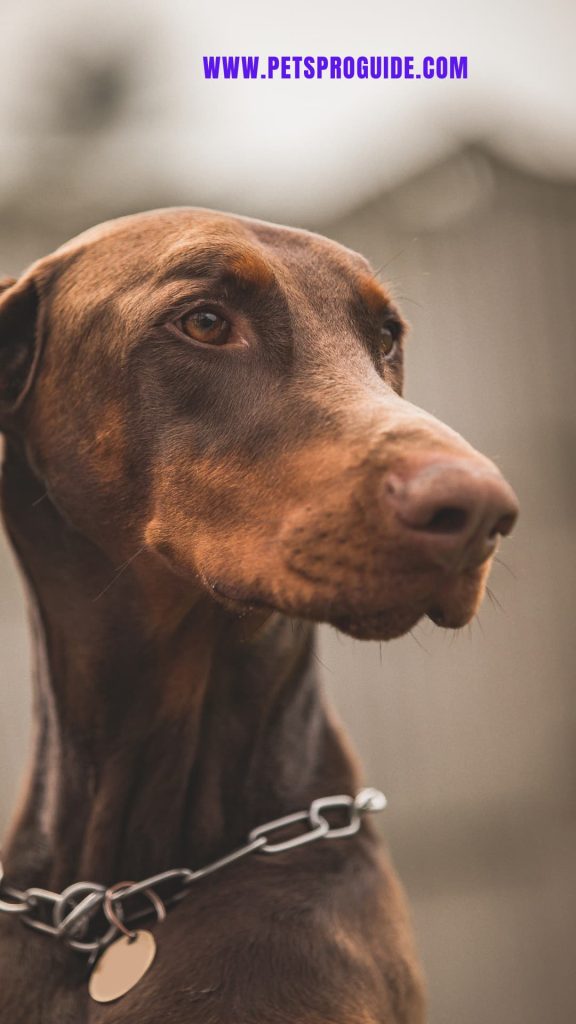

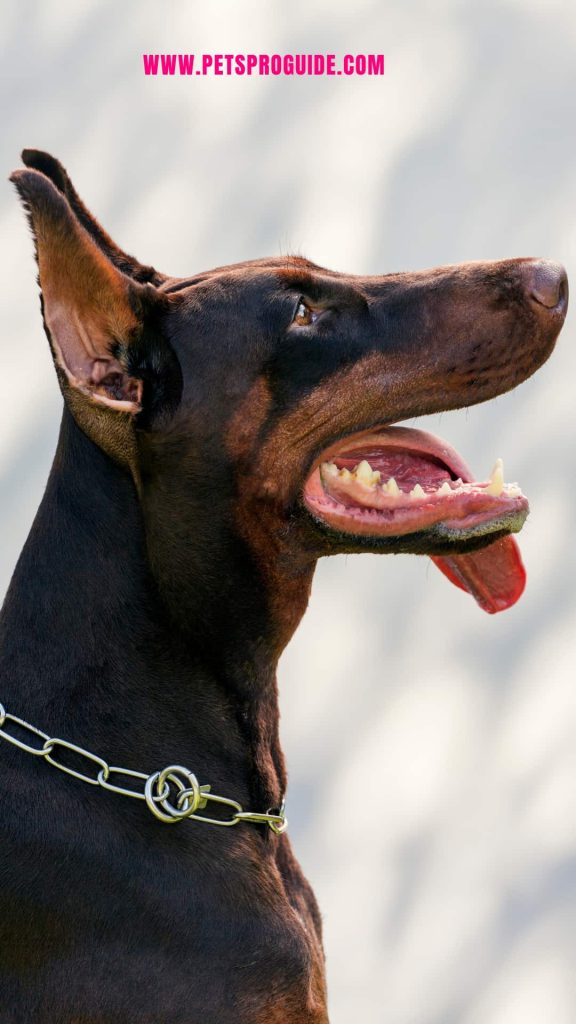
Conclusion
Doberman Pinschers are magnificent dogs known for their loyalty, intelligence, and striking appearance. They are versatile and adaptable, serving as loyal family companions, working dogs, and even movie stars. Before bringing a Doberman into your life, consider their needs, train them well, and provide them with the love and care they deserve. A well-raised Doberman can be a true testament to the bond between humans and their faithful canine companions.
If you really enjoyed the article “Doberman Pinschers Breed Information and Pictures,” then I would be very grateful if you’d help it spread by emailing it to your friends or sharing it on Twitter, Instagram, or Facebook. Thank you!
Read More
- Beagle Breed Information
- Affenpinscher Breed Information
- Bull Terrier Breed Information
- Doberman Pinschers Breed Information
- Dachshunds Breed Information





